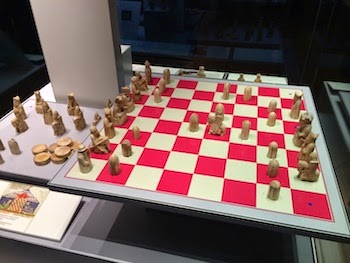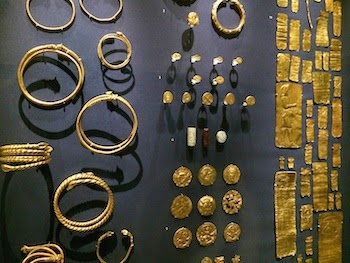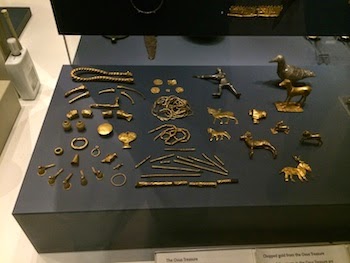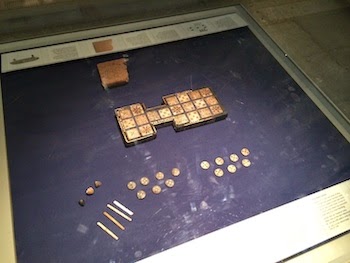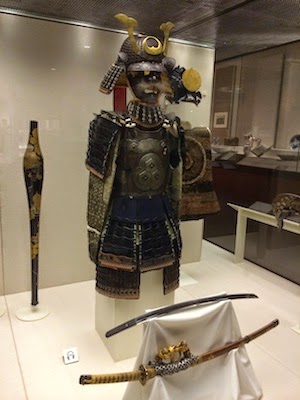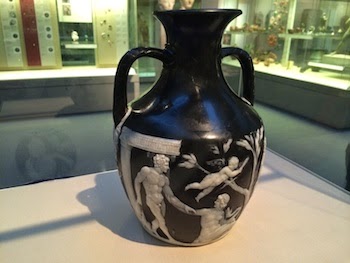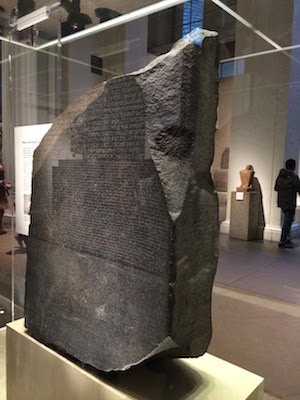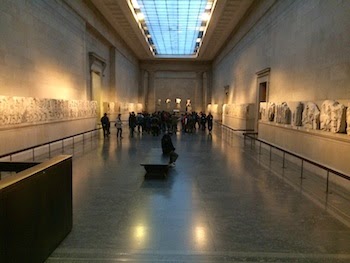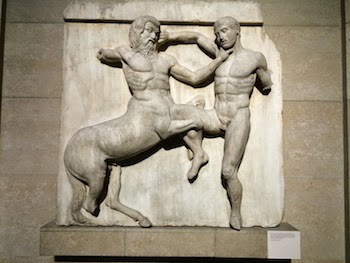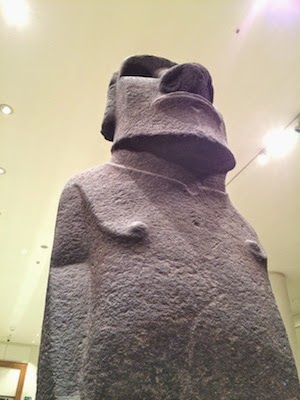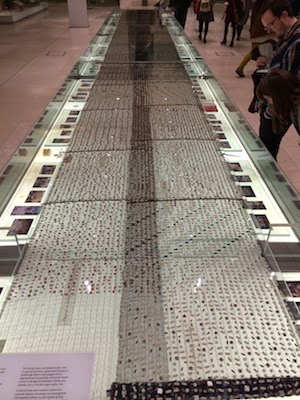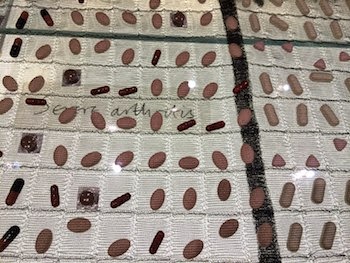 |
| The British Museum, London |
At one point, the British Empire covered a quarter of the globe. Think about that for a moment: at the height of the empire, you could pick any point (of land, I should add) on the globe, and there’d be a 1 in 4 chance it was controlled from London. For much of that time, the interesting and valuable things English explorers, captains, generals, and naturalists found were dismantled, packed, crated up and shipped back to London. We’ve always joked (only half-heartedly) that if something–some statue, some artifact, some treasure–is missing from an archaeological site or some other museum in the world, you’d find it at the British Museum. A real example of which is the topic of an upcoming blog.
The British Museum, like the Louvre in Paris, is a can’t-miss museum. If you go to London, you really shouldn’t miss it unless you’re just passing through. And also like the Louvre, you could spend several days in the British Museum: you might see everything, but your eyes will be glazed over by the time you leave. This empty-nest nomadic travel blogging couple has been to the British Museum before, so on this trip we were seeking a more abbreviated visit. In other words, we wanted to “hit the highlights”. Fortunately, the British Museum caters to such a visit. A few days before we arrived, we found a “1 Hour at the British Museum” guide on the museum’s website.
So. Here’s our version of “1 hour At The British Museum”, with an omission or two given our selected route, but with a couple of additions of really cool things we saw on the way.
1. The Lewis Chessmen
The Lewis Chessmen is one of the earliest chess sets ever found. The walrus ivory pieces were discovered on the Isle of Lewis in the Western Isles, Scotland, in 1831 (making it one of the artifacts that really should be in the British Museum). The medieval set consisted of 78 chessmen, 14 game counters, and (perhaps a trophy) an elaborately carved belt buckle. While most of the set is in the British Museum in London, eleven pieces can be seen at the National Museum of Scotland.
2. The Oxus Treasure
The Oxus Treasure is one of the largest hoards of 4th and 5th century gold and silver objects from the First Persian Empire. It was found in the 1800’s close to the river Oxus on the border of Afghanistan and Tajikistan. The artistic details–lions, rams, goats, some with turquoise inlays–are spectacular, considering some are 15 centuries old.
3. The Cyrus Cylinder
One of our personal additions to the British Museum power tour is the Cyrus Cylinder. We had first heard about this historical artifact by watching a TED talk a year or so ago by Neil MacGregor. If you don’t know what TED is, you’re in for a treat: click here. The Cyrus Cylinder is a piece of stone covered with ancient cuneiform writing dating from 539 BC. It tells how Cyrus the Great, ruler of Iran, peacefully captured Babylon and how he rebuilt the main template there.
If you’d like to see Neil’s TED talk and learn a lot more about the Cyrus Cylinder, click here.
4. The Royal Game of Ur
The Royal Game of Ur is a 4,600 year old board game found buried in royal graves, indicating how valuable the game was (and how long humans have been passing time with board games). It includes a game board inlaid with shell, red limestone and lapis lazuli. It was played in Ur (the city-state in Mesopotamia, as in “Ur of the Chaldeans”, Abraham’s homeland: Genesis 11:28) for three thousand years.
The game was played by two players rolling dice and racing to move seven identical pieces through identical paths on the board.
5. Feather Leaves Bowl
This is another item we added to our power tour. It’s neither British (it’s Japanese) nor ancient (it was made in 2013). It’s simply amazing. It’s a sculpture portraying a pot of a thousand leaves rustling in the wind. It’s pretty just to look at, but then know that it’s made of bisque porcelain.
This incredible piece of art was created by Japanese artist Hosono Hitomi, who works in her studio in London.
6. Samurai Armor
Also in the Japanese wing, this full suit of Samurai armor was made between 1500 and 1800. The metal plates are tied with silk. In the 1500’s, the Portuguese brought firearms to Japan, so a thick bullet-proof breastplate was added. The mask and horns are intended to instill fear.
7. The Portland Vase
The Portland Vase is a small vase of cameo glass made in Rome between 15 BC and 25 AD. It is one of the finest examples of Roman glass, remarkably complete and undamaged by the centuries, easy to imagine it was created just a century ago rather than twenty centuries ago. Except that in 1845, a museum visitor attacked it (for some reason) and broke it into 125 fragments. A museum conservator repaired it within five months, and the hairline cracks are only discernible upon very close inspection. It is named after the Dukes of Portland who owned it from 1785 to 1945. I would love to have this vase on my desk to deposit cigar ashes in as I write (just kidding).
8. The Rosetta Stone
I likely don’t have to tell you what the Rosetta Stone is, but I’ll summarize it this way: it’s the discovery from 1799 that allowed us to decipher ancient Egyptian writing. What we will mention that might supplement your knowledge is how it came to the British Museum. It was discovered in 1799 by Napolean’s forces near Rashid (Rosetta), Egypt, who immediately recognized its significance. The French were at war with the British at the time, and the French in Egypt were thereafter defeated by the British. The Rosetta Stone was specifically demanded by the British as part of the Treaty of Alexandria in 1801. Less than a year later, it was in the British Museum where it remains today. By 1825, ancient Egyptian hieroglyphics had been deciphered.
9. Sculptures of the Parthenon
The Parthenon in Athens is one of those places missing a few pieces that can be found in the British Museum (and causes ongoing consternation between the museum-ocrats in United Kingdom and Greece). The Parthenon was built between 447 and 438 BC and dedicated to Athena. It housed a huge gold and ivory statue of Athena by the sculptor Pheidia and the entire building was richly decorated. Part of those decorations were hundreds of representations of Greek mythology that ran along all four sides of the building. Though the artists knew these reliefs were to be viewed from a distance (from the ground), they’re of exquisite detail.
Note the closeup of the centaur fighting the man: we’ll blog about that one day soon.
10. Hoa Hakananai’a
Easter Island, I’m sure you know, is covered with large, enigmatic basalt statues staring out to sea (probably waiting for their Costa Cruise ship to come pick them up, and as a consequence, now are petrified). The British took this souvenir in the mid 1800’s. As best scientists can tell, it was carved by natives about 1400. This one is named “Hoa Hakananai’a”, which they think means (appropriately enough) “stolen friend”, perhaps “hidden friend”.
11. “Cradle to Grave” by Pharmacopoeia
Finally, this thought-provoking display (it’s hard to call it art) is a temporary installation that we thought worth mentioning from our power tour. It’s called “Cradle to Grave” and it’s a mesh fabric with all the fourteen thousand pills an average British man and woman (two separate mesh cloths) might consume during their lifetimes sewn in. Along the way, you see the conditions, ailments, and afflictions the persons might be contending with written beneath the mesh. It is an effective reminder of how many chemicals we put into our bodies.
If you’re lucky enough for this installation to still be on display when you visit, it’s worth a little extra time.


